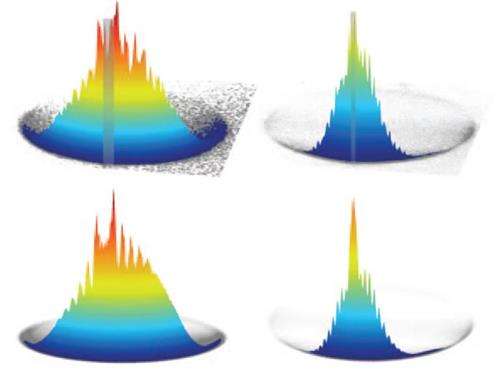Molecular collisions now imaged better than ever

Molecular physicists from Radboud University Nijmegen have produced images of the changes in direction of colliding nitrogen monoxide molecules (NO) with unprecedented sharpness. By combining a Stark decelerator with advanced imaging techniques, they were able to obtain very high resolution images of the collision processes. The results were published in Nature Chemistry on 9 February.
The project supervisor, Bas van de Meerakker, was also the first to achieve controlled collisions between two molecules and produced images of collision resonances during his stay as visiting professor in Bordeaux. While carrying out this research, Van de Meerakker and his colleagues detected diffraction oscillations - fluctuations in the angular distribution of the molecules - following a collision. These diffraction oscillations provide a unique image of the collision process. 'The changes in direction and, in particular, the oscillation structure that we observed, have long been predicted in theory. Even though we had hoped to be able to visualise this theory in high resolution using our decelerator, the fact that we actually achieved it is really quite something,' said Van de Meerakker (see Figure 1).
Ultimate demonstration of wave nature
'Diffraction oscillations are the ultimate demonstration of the wave nature of molecules and the collision process itself', said Van de Meerakker. 'For example, the diffraction of light is a well-known phenomenon that results from interference between light waves. Just like light, atoms and molecules are in fact waves, and can therefore reinforce or cancel out one another as they collide. This results in the oscillation structure that we saw. These data provide us with even more detailed information about the interaction between molecules and, ultimately, help us learn more about nature.'
The publication of their article in Nature Chemistry means that the molecular physicists are yet another step closer to the ultimate molecular collision experiment, in which all variables are controlled. Van de Meerakker's next step will therefore be to use not one but two Stark decelerators to control both beams of colliding molecules.
More information: State-resolved diffraction oscillations imaged for inelastic collisions of NO radicals with He, Ne and Ar. Alexander von Zastrow, Jolijn Onvlee, Sjoerd N. Vogels, Gerrit C. Groenenboom, Ad van der Avoird, Sebastiaan Y. T. van de Meerakker. Nature Chemistry (2014) Received 25 September 2013 Accepted 20 December 2013 Published online 09 February 2014. DOI: 10.1038/nchem.1860
Journal information: Nature Chemistry
Provided by Radboud University Nijmegen




















